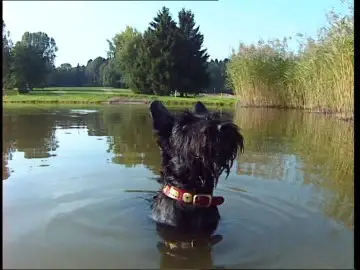This die-hard small dog breed is known to be a lot of fun and a great partner. If you love swimming, own or intend to own a Scottish terrier, you might be wondering if the Scottish terrier can swim.
So, can they swim?
Scottish Terriers, like most dogs, can naturally swim, but, they are not great swimmers and this is due to their short legs and dense body, which makes them sink faster than they swim.
Extra care and precaution have to be taken if you are to take your Scottie swimming and in this blog post, I will be looking at the various precautions you need to take, how to teach your Scottie to swim, and the dangers involved in taking your Scottie swimming, amongst other things.
So, let’s get started.
Do Scottish Terriers like Swimming?
Most Scottish Terriers have been found to love being in the water but it can’t be said for every Scottie.
Every dog tends to have their individual character traits and behavior, this implies that your Scottie might love going swimming and being in the water or not.
However, you can have considerable control over this by introducing your Scottie to swimming from an early puppy age, which is a great way to get them to really enjoy being in the pool or lake with you.
Later in this blog post, I will be detailing the various techniques you can employ when training your puppy Scottish terrier to swim.
How to teach your Scottish Terrier to Swim
The best time to teach a Scottie how to swim is when they are still a puppy.
Starting that young is a great way to gently introduce them to the feeling of being submerged in water.
This early-stage training is to be handled with the utmost care and attention because, if done wrong, your Scottie might develop a negative association with small and large bodies of water.
As earlier mentioned, starting out from an early puppy age can be a great way to help your Scottie get used to being in the water.
With that being said, here are some tips to help you teach your puppy Scottish terrier to swim:
- Get him/her started on a kiddies pool or your bath tub. This will help give you better control over what happens, as well as ensure your Scottie isn’t spooked.
- Place your hands over and under your Scottie to support him/her and slowly drop him/her into the water. Instinctively, their legs should start paddling.
- Let him/her go for a couple of seconds, all the while praising him/her for job well done.
After your Scottie has gotten used to being in water, the next big step would be to take him/her out on the lake or pool.
- It is important not to toss your Scottie into the lake or pool as they might get injured and develop a negative association with large bodies of water.
- At this stage, it is important to employ the use of a lifejacket as a safety precaution.
- Get into the pool before your Scottie, stand at the shallow end, then call him/her towards you if the pool has gradually descending levels, if not, gently carry him/her into the pool.
- Place your arm over and under him/her as you gently let him go into the water.
- Stay close to your Scottie in case he/she panics. Assisting your Scottie helps reassures him/her of his/her safety.
- Keep the training sessions short and reward your Scottie with treats and praises.
- It is important to also teach your Scottie how to exit the pool or lake, preferably, how it came in.
Safety tips when taking your Scottish terrier swimming in a Pool
Due to the Scottish terrier’s short legs and dense body, which puts him at a disadvantage when it comes to swimming, it is important to take certain safety precautions into account before taking your Scottie out into the water.
1. Use a Lifejacket
Lifejackets are essential in ensuring your Scottie not only stays safe and afloat, it also makes you feel more confident as you focus on spending ample time having fun and bonding with your pooch.
Lifejackets also ensure your Scottie doesn’t get tired and freaks out when paddling its feet gets sore and cramped up, making the whole experience a worthwhile event.
2. Take extra fresh drinking water
Taking fresh water with you on your swimming trips is helpful in ensuring your Scottie stays hydrated and prevents him/her from drinking the pool water.
The chlorine found in swimming pools can be harmful to your Scottie if ingested in excess, it is important to keep a watchful eye on your Scottie during the entire swimming duration to prevent this.
3. Keep a watchful eye on your Scottie
Due to their body type and legs, which makes them not so great at staying afloat, it is very important to always keep an eye out whenever your Scottie is in the water.
Never let him/her be in the water unsupervised, like i noted earlier, they tend to sink faster than they swim.
This is especially true with Scotties that have not being taught to swim.
4. Rinse your Scottie after the swimming session
It is important to properly rinse your Scottie with fresh water after a fun-filled day swimming in the pool.
Rinsing off any extra chlorine from your Scottie’s coat can prevent it from developing any skin issues and keeping his/her coat looking fresh.
Safety tips Scottish terrier swimming at the Lake
Taking your Scottie swimming at the lake is entirely different from taking them swimming at the pool.

Various factors need to be considered to ensure your fun time doesn’t end up with an emergency trip to the vet.
1. Do your research and ensure the lake is pet safe
Ensure the lake you intend to go swimming in isn’t toxic to both humans and dogs and doesn’t have certain things that can cause harm to your Scottie.
These things include:
- Water snakes or other water-dwelling animals that can inflict harm on or even kill your Scottie.
- Debris, broken glass, fishing hooks, and other sharp objects that can easily cut your Scottie or poke its eyes while swimming.
2. Avoid slow-moving, stagnant lakes
It is important to do your research and ensure the lake isn’t slow moving nor stagnant as it could be harboring brain-eating amoebas, often found in hot, stagnant water src.
Ensure your Scottie doesn’t drink the lake water as he/she could stand the risk of blue-green algae poisoning
The blue-green algae are commonly found in hot, slow-moving, and stagnant waters. It can be toxic to your Scottie if it is consumed in high quantities. src
Symptoms of blue-green algae poisoning include diarrhea or vomiting, drooling, weakness, collapse/unconsciousness, seizures, disorientation/confusion, and breathing difficulties.
3. Be extra careful in the salmon or trout-filled lake
If you intend swimming in salmon or trout-filled lakes, like those around the Pacific Northwest of the US or in British Columbia, Canada, ensure your Scottie doesn’t eat any salmon or trout as he/she risks getting salmon poison.
Salmon, and other salmonid fish (including trout and char), in these parts of North America, can contain a type of bacteria and a parasitic fluke. src
4. Take fresh water with you
It is important to take caution and prevent your Scottie from drinking the lake water.
You can do this by taking fresh water on your swimming trip, this will come in handy when your Scottie gets tired and thirsty.
It can also be used to rinse your Scottie after swimming. This should be done to take off any extra element picked up from swimming at the lake.
Do ensure to run your fingers through your Scottie’s hair to properly ensure nothing stays behind. Afterwards, dry him/her up with a clean towel.
Risk Involved
It is well defined that the Scottish terrier isn’t built to be a great swimmer due to its body structure and short legs, but with the aid of a lifejacket, can have a funfilled day at the pool.
In this section we have to look at some, not-so-well-known risks associated with taking your Scottie swimming.
It’s quite clear that drowning is a well-known risk involved in swimming, even with humans, but here are some you might have not thought about or are unaware of.
Water Intoxication
This is caused when you have excess water intake during swimming. Water intoxication is also known as water poisoning or hyperhydration.
According to the American Kennel Club, when a dog experiences water intoxication, the sodium levels outside the cells are depleted, a condition called hyponatremia.
In an effort to rebalance itself, the body responds to the low blood sodium by increasing fluid intake inside the cells.
Due to their small size, it will be harder for your Scottie to take out the excess water out from his/her system.
Smaller dogs have a higher risk of suffering from water intoxication than bigger dogs.
Some symptoms of water intoxication are bloating, lethargy, pale gums, drooling, vomiting, dilated pupils, restlessness, and glazed eyes src.
Preventing Water Intoxication
To prevent this from happening, it is important to take breaks while swimming to ensure your Scottie gets all the rest it needs.
It is important to keep an eye on your Scottie, ensure they don’t stay underwater for too long.
Leptospirosis
This is a disease carried by domestic livestock, rodents, wildlife and are often found during the late summer and fall seasons.
It can be found all over the world.
The organism causing leptospirosis is called spirochete bacteria and can be found in mud pools, dampness and stagnant pools of water.
Your Scottie can get infected if he/she ingests or swim in water infested with this organism.
Some symptoms of leptospirosis are poor appetite, fever, vomiting, increased thirst, lethargy, and increased urine production.
Symptoms may take over 4-12 days before they become noticeable.
Preventing Leptospirosis
One of the best ways to prevent your Scottie from getting easily infected is by vaccinating him/her early on.
Keep away from stagnant pools of water, ensuring your Scottie doesn’t drink from it.
Keep their living quarters and crates clean to prevent rodent infestation.
It is important to note that leptospirosis is also a zoonotic disease, meaning even us humans can contract it as well.
They can transmit it to humans, if they have been infected, when they lick your face.
Conclusion
Although the Scottish terrier isn’t great at swimming, they can be taught to swim, with proper supervision and the use of a life jacket, they can accompany you on your fun-filled swimming trip.
Swimming can be a great form of exercise to help keep your Scottie healthy and fit, so it should be something you may need to consider.

